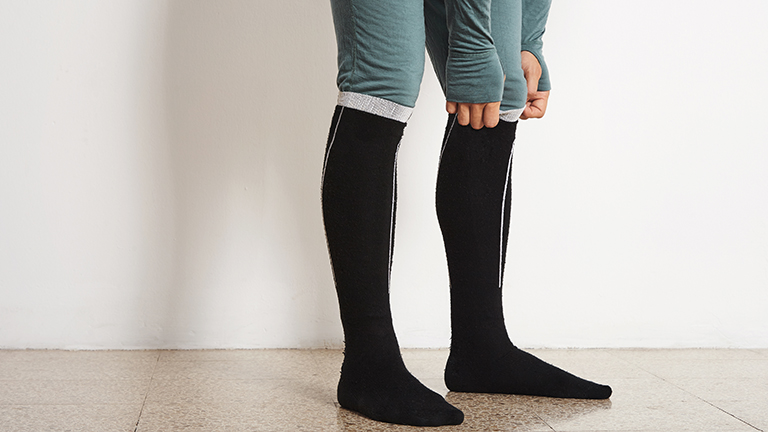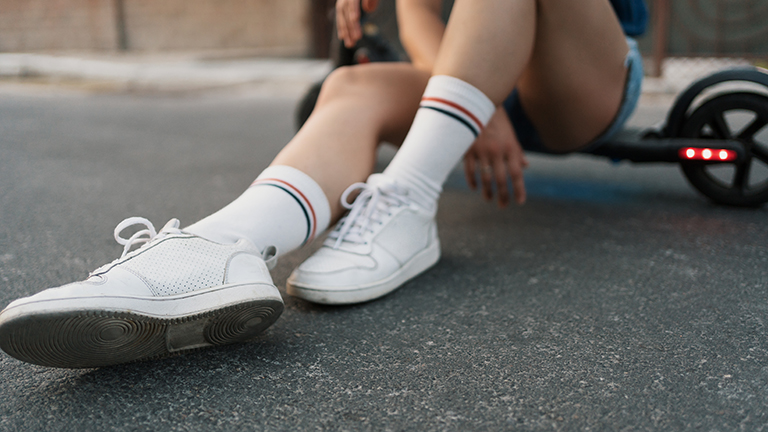Compression socks are specialized hosiery designed to improve blood flow in the legs and feet by applying gentle, graduated pressure. Unlike regular socks, they are tighter at the ankle and gradually loosen toward the calf or thigh, promoting venous return and reducing blood pooling. They are commonly used for medical purposes, including preventing deep vein thrombosis, improving circulation, and reducing swelling. However, in recent years, compression socks have become increasingly popular among travellers, particularly for long flights, due to their ability to reduce fatigue, leg discomfort, and swelling associated with prolonged sitting.
Travellers often underestimate the physical strain of sitting for extended periods in cramped air plane seats. Without adequate movement, blood circulation in the lower extremities can slow down, leading to swelling, stiffness, and in severe cases, blood clots. Compression socks for long flights provide an effective solution, enhancing comfort and promoting overall leg health. By improving circulation, these socks reduce the risk of complications and allow passengers to arrive at their destination feeling more refreshed.
How Compression Socks Improve Circulation During Flights
The primary function of compression socks is to enhance venous blood flow in the lower extremities. During long flights, the combination of immobility, low cabin pressure, and dehydration can cause the veins in the legs to expand, leading to discomfort and swelling. Compression socks apply consistent pressure that helps push blood back toward the heart, preventing it from pooling in the legs.
Compression socks also provide a subtle massaging effect, which encourages continuous circulation and helps reduce fatigue. Improved circulation not only reduces swelling but also minimises the risk of developing deep vein thrombosis (DVT), a potentially serious condition characterised by blood clots in the deep veins of the legs. Regular use of travel compression socks ensures that blood keeps flowing efficiently, even when passengers remain seated for hours, making long flights safer and more comfortable.
Benefits of Wearing Compression Socks on Long Flights
Reduce Swelling and Fatigue
Swelling in the feet and ankles is a common complaint among long-haul travellers. Immobility during flights causes fluid to accumulate in the lower extremities, leading to puffiness and discomfort. Compression socks help counteract this by applying targeted pressure that prevents fluid buildup. As a result, travellers experience less fatigue, lighter legs, and improved comfort during and after the flight.
Prevent Deep Vein Thrombosis (DVT)
One of the most significant health benefits of wearing compression socks on flights is the prevention of deep vein thrombosis. DVT occurs when a blood clot forms in a deep vein, usually in the legs, which can potentially travel to the lungs and cause a pulmonary embolism. Prolonged sitting, dehydration, and restricted movement increase the risk of DVT during air travel. Compression socks support venous blood flow, reducing the likelihood of clot formation and providing peace of mind for travellers, especially those with pre-existing risk factors.
Improve Overall Comfort
Beyond the medical benefits, compression socks enhance general comfort while flying. They reduce the feeling of heaviness in the legs, prevent muscle soreness, and make walking upon arrival easier. Many travelers report that wearing compression socks allows them to enjoy their trips more fully, as they are less distracted by discomfort or fatigue. Additionally, modern compression socks come in stylish designs, making them a practical and fashionable choice for both casual and business travellers.
How to Choose the Right Compression Socks for Air Travel
Compression Levels Explained (mmHg)
Compression socks are available in various levels of pressure, measured in millimetres of mercury (mmHg). For most travellers, moderate compression between 15-20 mmHg is recommended. This level is effective in promoting circulation, preventing swelling, and enhancing comfort without causing excessive tightness. Travellers with higher medical risks may require stronger compression, such as 20-30 mmHg or even 30-40 mmHg, but it is essential to consult a healthcare professional before using high-pressure socks to avoid complications.
Material and Fit Considerations
The material of compression socks significantly affects comfort and performance. High-quality materials such as nylon, spandex, and merino wool offer breath ability, moisture-wicking properties, and durability. Proper fit is equally important; socks that are too tight can restrict circulation, while loose socks will fail to provide the necessary compression. Measuring the circumference of the ankle, calf, and sometimes thigh is crucial to ensure optimal fit and effectiveness.
Style Options: Knee-High vs. Thigh-High
Compression socks come in various styles, including knee-high, thigh-high, and full-length stockings. Knee-high socks are the most popular choice for air travel, as they are easy to wear, provide sufficient coverage for the lower legs, and are comfortable under trousers or skirts. Thigh-high or full-length stockings may offer additional benefits for individuals with specific medical needs or extensive leg swelling, but they may be less convenient for casual travel use.
Top Selections Explained:
- Sockwell Elevation Firm Graduated Compression Socks
These socks are praised for their firm support and high-quality materials, making them ideal for travelers seeking enhanced circulation during flights. Verywell Fit - Charmking Compression Socks
A budget-friendly option with over 62,000 five-star ratings on Amazon. They offer a compression range of 15–20 mmHg, suitable for most travelers. Travel + Leisure - Trtl Travel Compression Socks
Designed with COOLMAX® and LYCRA® for a comfortable fit, these socks provide gentle compression of 15–21 mmHg, reducing swelling and promoting circulation. TrtlTravel - JOBST Travel Compression Socks
These knee-high socks offer 15–20 mmHg compression, helping improve circulation and minimise swelling during long periods of sitting or standing. Amazon - Sockwell Men’s In Flight Graduated Compression Socks
Known for their moderate graduated compression, these socks are comfortable for long flights and daily wear, providing support without being restrictive. Sockwell
Each of these options caters to different preferences and budgets, ensuring you can find the perfect pair to keep your legs comfortable during long flights.
Tips for Wearing Compression Socks on Long Flights
When to Put Them On
Compression socks should be worn before boarding the flight and while seated during the journey. Putting them on before departure ensures that your legs receive continuous support from the moment you start traveling. Wearing compression socks throughout the flight maximises their effectiveness in preventing swelling and promoting circulation.
Duration and Frequency
For most travellers, wearing compression socks for the entire duration of the flight is ideal. For longer journeys exceeding eight hours, consider giving your legs a brief break during bathroom visits, but do not remove the socks for extended periods. Regular use of compression socks for each flight is recommended, especially for individuals with a history of leg discomfort or circulatory issues.
Care and Maintenance
Proper care ensures that compression socks maintain their elasticity and effectiveness over time. Most compression socks are machine washable but should be placed in a gentle cycle and air-dried. Avoid using bleach or fabric softeners, as these can damage the fibers. Inspect socks regularly for signs of wear and replace them when elasticity diminishes to ensure continued support.
Top Recommended Compression Socks for Travellers
Budget Options
Affordable compression socks offer essential support without compromising quality. Many budget-friendly brands provide moderate compression levels and durable materials, making them suitable for occasional travellers. These socks are ideal for individuals seeking basic circulation support during flights without investing in premium options.
Premium Options
Premium compression socks are designed with advanced materials, ergonomic designs, and enhanced comfort features. They offer superior breath ability, moisture management, and precise graduated compression. These socks are particularly beneficial for frequent flyers, business travellers, and individuals with a higher risk of leg complications. While more expensive, premium socks provide long-term comfort, durability, and health benefits.
Best for Men and Women
Compression socks are available in styles tailored for both men and women. Women’s socks often feature slimmer designs, softer fabrics, and fashionable colours, while men’s socks focus on broader sizing and neutral tones suitable for professional attire. Choosing gender-specific designs ensures optimal fit, comfort, and style for every traveler.
Common Myths About Compression Socks Debunked
Despite their popularity, several myths persist about compression socks. One misconception is that compression socks are only necessary for individuals with medical conditions. In reality, anyone travelling long distances or sitting for extended periods can benefit from them. Another myth is that compression socks are uncomfortable and restrictive. High-quality compression socks are designed for comfort, breath ability, and style, making them suitable for daily use. Additionally, some travellers believe that wearing compression socks guarantees complete prevention of DVT. While they significantly reduce risk, they should be used alongside other preventive measures such as movement and hydration.
Other Ways to Improve Leg Health During Flights
Foot Exercises and Movement
In addition to wearing compression socks, performing simple foot and leg exercises during the flight can improve circulation and reduce stiffness. Flexing the ankles, rotating the feet, and standing or walking periodically help stimulate blood flow and prevent discomfort. Even small movements while seated, such as heel lifts or toe taps, can make a noticeable difference in leg health.
Hydration Tips
Air plane cabins have low humidity, which can contribute to dehydration and circulation problems. Drinking sufficient water throughout the flight helps maintain fluid balance, reduce swelling, and support overall well-being. Avoid excessive caffeine or alcohol, as these can further dehydrate the body and exacerbate leg discomfort.
Avoiding Prolonged Sitting
While compression socks help mitigate the effects of prolonged sitting, regular movement remains essential. Whenever possible, stand up, walk along the aisle, or perform stretching exercises. Combining compression socks with periodic activity offers the most effective strategy for preventing leg swelling, fatigue, and circulatory complications during long flights.
Conclusion: Are Compression Socks Worth It for Long Flights?
Compression socks for long flights are an effective and practical solution for maintaining leg health, enhancing comfort, and preventing complications such as swelling and deep vein thrombosis. Whether you are a frequent traveller, a business professional, or someone with a predisposition to circulatory issues, wearing compression socks ensures that your legs remain supported throughout the journey. By choosing the right fit, compression level, and style, and combining their use with movement and hydration, travellers can arrive at their destinations feeling refreshed and energised. Compression socks are not just a preventive measure—they are a travel essential for long-haul comfort and well-being.
FAQ: Compression Socks for Long Flights
Can Compression Socks Prevent Blood Clots?
Compression socks significantly reduce the risk of blood clots, especially during long flights, by promoting venous blood flow. However, they should be used in conjunction with movement and hydration for maximum effectiveness. Individuals with high-risk medical conditions should consult their healthcare provider before flying.
How Tight Should Compression Socks Be?
Compression socks should provide firm support without causing discomfort. Moderate compression levels between 15-20 mmHg are generally suitable for most travellers. Proper measurement of the ankle and calf ensures optimal fit and circulation support.
Can I Wear Compression Socks Every Day?
Yes, compression socks can be worn daily, particularly for individuals who stand or sit for extended periods. Daily use supports leg health, prevents swelling, and reduces fatigue. It is essential to follow care instructions to maintain elasticity and effectiveness.
Are Knee-High Socks Better Than Thigh-High Socks for Flights?
Knee-high socks are the most practical option for air travel, providing sufficient support for most passengers while being easy to wear and discreet under clothing. Thigh-high socks may offer additional benefits for specific medical needs but are generally less convenient for casual travel.
Can Compression Socks Improve Post-Flight Recovery?
Wearing compression socks during and after a flight helps reduce swelling, alleviate fatigue, and support faster recovery of leg muscles. They are particularly beneficial for long-haul travellers or individuals engaging in physically demanding activities upon arrival.


